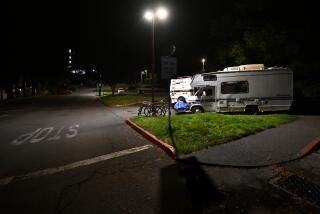Parents are dropping out of the college cost fight
It all came down to money this week on my return trip to San Francisco.
And there is good news and bad news in this.
The good news is that my daughter finally found a place to live. It’s a studio apartment, above a tavern, on a grimy stretch of a busy street. But it’s cheap and clean, with a real kitchen and a private bathroom, unlike the other prospects we’d seen.
And it’s a straight shot — one bus — to San Francisco State, where she will be a junior this fall.
That is where the bad news comes in. Her tuition will jump again — by about $600 — this fall. That’s the fourth tuition increase imposed by Cal State University trustees since 2009.
That hikes fees and tuition for classes to more than $6,000 a year, about $2,000 more than we expected when my youngest daughter enrolled as a freshman two years ago.
That’s double trouble for me. Her sister is a senior at Cal State Northridge, so our family is on the hook this year for $4,000 more than I budgeted back when an education in the Cal State system seemed like such a great idea.
That’s the personal toll of a public tragedy. State financing for higher education has been rolled back to levels unseen in years. This year’s budget cuts funding by 20%. That translates to $650 million less, and that has to be covered by somebody.
The poorest kids keep their financial aid; the richest write bigger checks. And the middle-class families get crushed in the crunch, relying on loans to cover the gap.
We can blame the economy, the trustees, the politicians, the citizenry’s lack of collective will.
What we can’t do is keep pretending we don’t see it.
::
Students have done their best to fight back. They’ve camped out, sat in and shut down city streets and campus buildings, trying to be heard.
They felt the impact of cuts on campus, in cancelled courses, crowded classes and teaching time lost to forced furloughs. In one year, the Cal State system lost 2,500 instructors — 10% of the faculty across the 23 campuses. Students were shut out in record numbers, graduations delayed and transfers stopped.
In April, with more cuts on the table, thousands of students, professors and campus employees joined marches and rallies across California. They were protesting a double whammy — $500 million in budget cuts, and a $500 hike in student fees — numbers that would keep rising this summer.
It’s parents who have been conspicuously absent, with little to show for their collective concern but a Facebook page that is eerily quiet.
I don’t know where to channel my anger, and I’m not sure how to read the silence.
Are we too disconnected to organize, or just too busy making a living? Are we so fed up with politics that we feel helpless to intervene? Or do we still see our system as such a bargain that we don’t mind being forced to dig deeper?
I went for answers to an expert, Cal State Northridge Provost Harold Hellenbrand, who has been with the system for 25 years. His postings on the CSUN website made the magnitude of the financial plight clear.
And even he has been surprised by the lack of outrage from parents in recent years.
“There’s so much less protest than I would have imagined,” he said. “We don’t hear that much from parents at all, given that we have 35,000 or 36,000 students” at CSUN.
Many of those are older students footing tuition bills themselves, busy working their way through school.
And at least half of the undergrads at Cal State Northridge — and at most of the system’s other urban campuses — qualify for financial aid grants that blunt the pain of fee increases.
“Which raises the question,” Hellenbrand said, “why aren’t upper-middle-class parents protesting more? They’re the ones getting screwed by this.”
The answer, he suspects, rests on a shift in perspective that has occurred in the last 20 years: Higher education is seen as more of a commodity and less of a right than it was back then.
“It’s seen as a commercial good,” he said, “something we’ve become acculturated to paying for, as a product.”
That makes sense, given the transition that has occurred as well in public schools. The free education of big urban districts is seen as the province of the poor by some upper-middle-class families used to shelling out for private schools.
Compared to tuitions at some private high schools, $6,000 a year for college doesn’t seem like much.
Add to that the “discounting effect” of community colleges, and California’s tiered system of higher education makes public universities — fee hikes and all — seem like a bargain, the provost said.
About half of CSUN’s students begin their studies with two years at a less expensive community college. That puts the cost of “a four-year degree … under $15,000.”
That’s if you can graduate in four years, which course cutbacks just keep making harder.
::
Hellenbrand likened the situation in California to the story of the frog in boiling water. You put him in a pot before it’s hot, then gradually raise the temperature and the frog doesn’t register that he’s dying.
“I think this has been going on so gradually, for so long, people have gotten used to it, unfortunately.”
Unfortunately, indeed.
We’re uncomfortably warm right now, but we’ll adjust as the year goes on. And next year the heat will rise again, and we won’t recognize the boiling point.
Consider me boiled. It seems pointless now to complain or protest.
I’m grateful for a tiny apartment on a busy street above a tavern.
And a college system I support with my taxes — and now my tuition — where my daughter fights for a spot in a classroom so crowded she sits on the floor.
More to Read
Start your day right
Sign up for Essential California for news, features and recommendations from the L.A. Times and beyond in your inbox six days a week.
You may occasionally receive promotional content from the Los Angeles Times.






